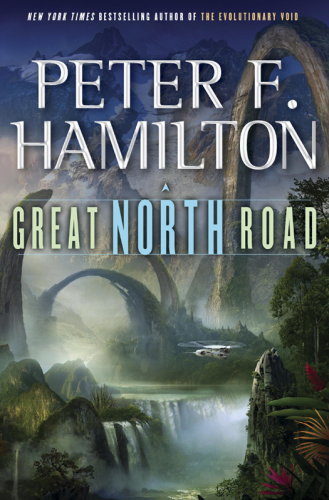
Great North Road
- اطلاعات
- نقد و بررسی
- دیدگاه کاربران
نقد و بررسی

Starred review from October 1, 2012
Hamilton’s stand-alone near-future mystery is a mesmerizing page-turner whose pace never lags despite the book’s substantial length. In 2143, Newcastle police detective Sidney Hurst realizes that a naked corpse dragged from the river was a member of the North family. Clones Augustine, Bartram, and Constantine North founded a company that invested in trans-spatial connection, a technology that opened gateways to other star systems and expanded humanity’s access to energy and living space. They cloned themselves in turn, by the hundreds. The wounds on the dead North, whose exact identity is vexingly hard to pin down, match those on Bartram’s body after he and his household were slaughtered in 2121—and Angela Tramelo, convicted of those murders, always claimed that an alien monster was the real culprit. The intense whodunit plot and the sustained ambiguity about Tramelo’s innocence or guilt are enhanced by plausible extrapolations of 22nd-century human cultures. Agents: James MacDonald Lockhart, Antony Harwood Ltd. (U.K.); Anthony Gardner, Gardner Literary (U.S.).

October 15, 2012
Part murder mystery, part alien-contact thriller, Hamilton's latest doorstopper (The Evolutionary Void, 2010, etc.) takes place in the early 23rd century when, thanks to the invention of wormhole technology, distant planets have been discovered and colonized. On St. Libra, a world of advanced plants but curiously no animals, not even insects, huge "bioil" farms produce the gasoline that, pumped via wormhole to Newcastle-Upon-Tyne in northeast England, feeds Earth's insatiable appetite for petroleum products. Instrumental in all this is the powerful North family, three generations of clones whose original three clone brothers have developed a friendly rivalry. Predictably, then, when the corpse of a North is found floating in the River Tyne, the Norths and other powers that be take a strong and immediate interest. Capable detective Sidney Hurst doesn't want the case--he can't stand the politics, and this figures to be nothing but. Yet, there are intriguing aspects: The North cannot be identified, and nobody admits to having mislaid one; and the murder method is--almost unique. Twenty years ago on St. Libra, another North clone and his entire household were slaughtered by the same grisly means. The convicted murderer, Angela Tramelo, who was working in the house as a prostitute, protested her innocence. Problem was, she claimed the killer was an alien monster. So now, Sidney confronts the possibility that a monster is loose in his city. Meanwhile, a military expedition is hurriedly organized and sent to St. Libra with Angela (who's by no means as innocent as she seems) aboard, but it runs into terrifying complications. Hamilton's development proceeds in familiar fashion: complicated but well-articulated plotting, life-sized main characters, intriguing extrapolation, plenty of crisp action and padding--via barely relevant subplots, long chunks of scene-setting and bizarrely verbose introductions to bit players that even regulars will skim or skip. One of Hamilton's better outings, caveats and all.
COPYRIGHT(2012) Kirkus Reviews, ALL RIGHTS RESERVED.

Starred review from November 15, 2012
In the 22nd century, bioil (plant-based fuel) dominates the economy, with off-planet sources providing most of the supply. When an apparently invisible monster stalks a scientific expedition investigating a largely unexplored but resource-filled planet, a 22-year-old murder case may hold the answers that can save the lives of the exploratory team and bring justice to a woman perhaps wrongly convicted of mass murder. The author of the Void Trilogy (The Dreaming Void; The Temporal Void; The Evolutionary Void) has written a gripping saga that blends wilderness survival, police procedural, political and social intrigue, and dynastic sf into a mammoth tale featuring believable characters and exceptionally skilled storytelling. VERDICT Hamilton excels at telling "big" stories, and his latest novel proves no exception. A stand-alone thriller with potential for multivolume expansions set in an all-too-believable future, this should appeal to a wide audience and have crossover potential for mainstream thriller fans.
Copyright 2012 Library Journal, LLC Used with permission.

Starred review from November 1, 2012
Hamilton, the increasingly popular British science-fiction writer, tends to write long, but he also writes well. Someone else might have told this story in half the space, but it probably wouldn't have been nearly as good. The story is simple enough: in the year 2143, a man is murdered, and Sidney Hurst, the detective assigned to the case, must wade through the evidence to find the culprit. Well, wade isn't exactly the word, because the evidence is pretty sparse. Physical traces of the murderer are virtually nonexistent, the scene of the crime is unknown (the body was dumped), and even the victim's identity is a mystery. Hurst knows the dead man is a North, a member of an extended family of clones, but nobody seems to be able to figure out which of the many hundreds of Norths he might be. Oh, and there's also the tantalizing possibility that the unknown killer might be the same creature that slaughtered another North and 13 other people two decades ago. And that's just the setup of this epic-size SF mystery (which morphs, the deeper you go into the story, into something else entirely). The author's rapidly growing legion of fans will flock to this new title, and readers unfamiliar with Hamilton's brand of SF should be steered in its direction. It's a perfect introduction to his gifts for character design, dialogue, and sheer, big-idea-driven storytelling.(Reprinted with permission of Booklist, copyright 2012, American Library Association.)




دیدگاه کاربران